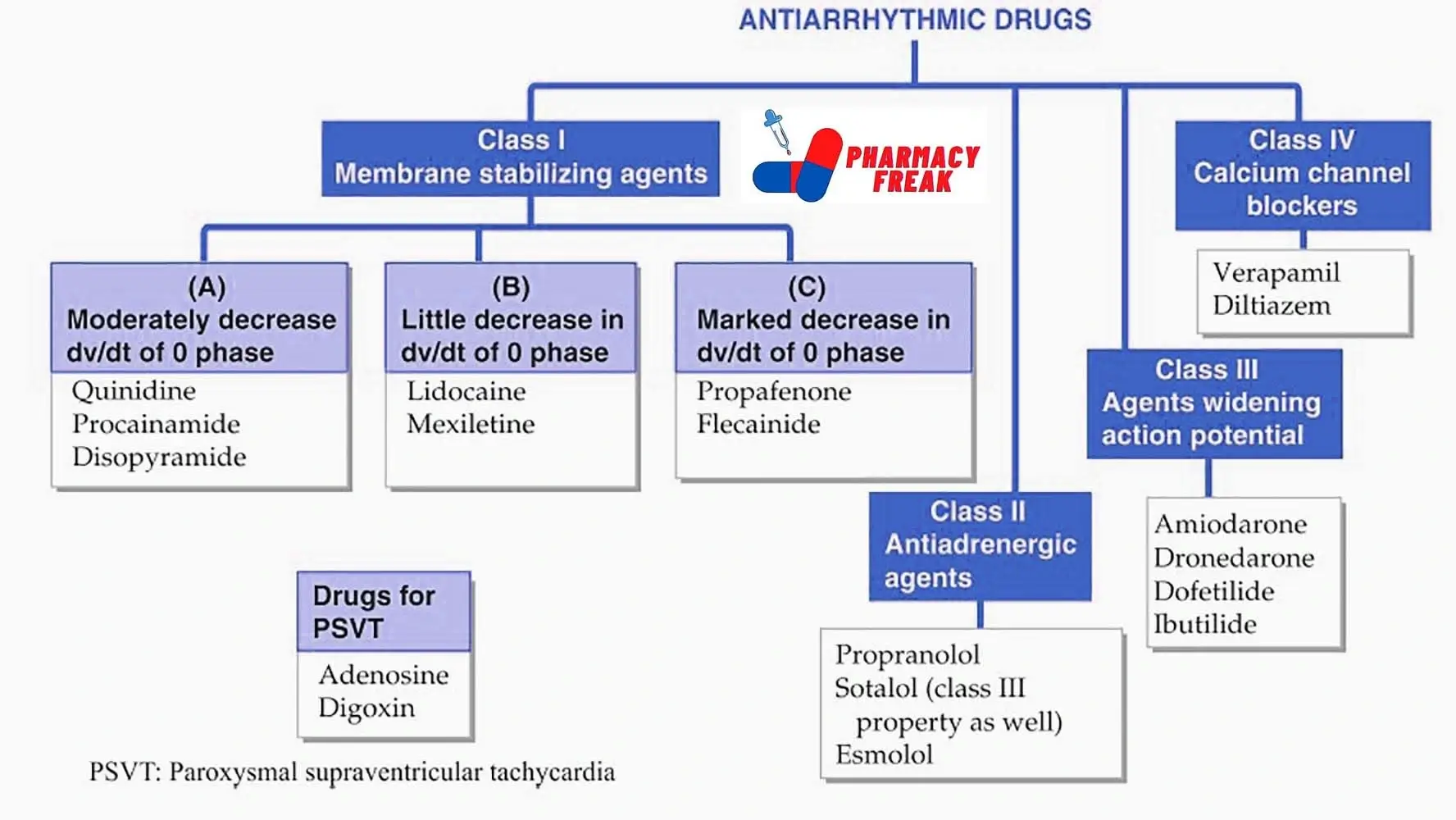Antiarrhythmic drugs are a category of medications that are vital in managing heart rhythm disorders, medically known as arrhythmias. These drugs play a significant role in regulating abnormal heart rhythms and maintaining a healthy heartbeat. Let’s explore the classification of antiarrhythmic drugs and how they help manage this critical aspect of heart health.
Table of Contents
Classification of Antiarrhythmic Drugs
Antiarrhythmic drugs can be categorized into different classes based on their mechanisms of action:
- Class I (Membrane stabilizing agents)
- Moderately decrease dv/dt of 0 phase- Quinidine, Procainamide, Disopyramide
- (B)Little decrease in dv/dt of 0 phase- Lidocaine, Mexiletine
- Marked decrease in dv/dt of 0 phase– Propafenone, Flecainide
- Class II- Sotalol (class III property as well), Esmolol
- Class III- (Agents widening action potential)- Amiodarone, Dronedarone, Dofetilide, Ibutilide
- Class IV (Calcium channel blockers)- Verapamil, Diltiazem
- Class I – Sodium Channel Blockers:
- These drugs, such as lidocaine and flecainide, work by blocking sodium channels in heart cells. By doing so, they decrease the speed of electrical signals in the heart, helping to restore a regular heart rhythm.
- Class II – Beta-Blockers:
- Beta-blockers, like propranolol and metoprolol, reduce the heart’s workload by blocking the effects of adrenaline. This leads to a slower heart rate and decreased force of contractions, which can help manage certain arrhythmias.
- Class III – Potassium Channel Blockers:
- Medications in this class, including amiodarone and sotalol, affect potassium channels in the heart cells. They prolong the repolarization phase of the heart’s electrical cycle, helping to prevent abnormal rhythms.
- Class IV – Calcium Channel Blockers:
- Calcium channel blockers, such as verapamil and diltiazem, work by blocking calcium channels in the heart. By doing so, they slow down the heart rate and reduce the strength of contractions.
- Other Agents:
- Some drugs don’t fit into the traditional classification but are used to manage arrhythmias. For example, adenosine is used to treat specific supraventricular arrhythmias by slowing down electrical conduction in the heart.
- Combination Therapy:
- In some cases, healthcare providers may prescribe a combination of antiarrhythmic drugs to better control and manage certain types of arrhythmias.
Common Uses of Antiarrhythmic Drugs
Antiarrhythmic drugs are primarily used to treat arrhythmias, which are abnormal heart rhythms. These medications serve several important purposes:
- Restoring Normal Heart Rhythm: The primary goal of antiarrhythmic drugs is to restore a regular heart rhythm when an arrhythmia is detected.
- Preventing Arrhythmia Recurrence: These drugs help prevent the recurrence of arrhythmias, ensuring a stable heartbeat over time.
- Improving Heart Function: By regulating heart rhythm, antiarrhythmic drugs contribute to the overall well-being of the heart and its pumping function.
Reference
- Classification of Progestins- KD Tripathi
- National Library of Medicine- Classification of Antiarrhythmic Drugs
Related Links

I am a Registered Pharmacist under the Pharmacy Act, 1948, and the founder of PharmacyFreak.com. I hold a Bachelor of Pharmacy degree from Rungta College of Pharmaceutical Science and Research. With a strong academic foundation and practical knowledge, I am committed to providing accurate, easy-to-understand content to support pharmacy students and professionals. My aim is to make complex pharmaceutical concepts accessible and useful for real-world application.
Mail- Sachin@pharmacyfreak.com

